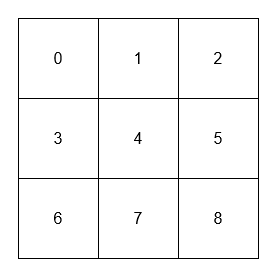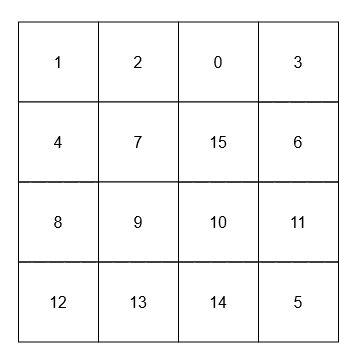Description
You are given a n x n 2D array grid containing distinct elements in the range [0, n2 - 1].
Implement the NeighborSum class:
NeighborSum(int [][]grid)initializes the object.int adjacentSum(int value)returns the sum of elements which are adjacent neighbors ofvalue, that is either to the top, left, right, or bottom ofvalueingrid.int diagonalSum(int value)returns the sum of elements which are diagonal neighbors ofvalue, that is either to the top-left, top-right, bottom-left, or bottom-right ofvalueingrid.

Example 1:
Input:
["NeighborSum", "adjacentSum", "adjacentSum", "diagonalSum", "diagonalSum"]
[[[[0, 1, 2], [3, 4, 5], [6, 7, 8]]], [1], [4], [4], [8]]
Output: [null, 6, 16, 16, 4]
Explanation:

- The adjacent neighbors of 1 are 0, 2, and 4.
- The adjacent neighbors of 4 are 1, 3, 5, and 7.
- The diagonal neighbors of 4 are 0, 2, 6, and 8.
- The diagonal neighbor of 8 is 4.
Example 2:
Input:
["NeighborSum", "adjacentSum", "diagonalSum"]
[[[[1, 2, 0, 3], [4, 7, 15, 6], [8, 9, 10, 11], [12, 13, 14, 5]]], [15], [9]]
Output: [null, 23, 45]
Explanation:

- The adjacent neighbors of 15 are 0, 10, 7, and 6.
- The diagonal neighbors of 9 are 4, 12, 14, and 15.
Constraints:
3 <= n == grid.length == grid[0].length <= 100 <= grid[i][j] <= n2 - 1- All
grid[i][j]are distinct. valueinadjacentSumanddiagonalSumwill be in the range[0, n2 - 1].- At most
2 * n2calls will be made toadjacentSumanddiagonalSum.
Solution
Python3
class neighborSum:
def __init__(self, grid: List[List[int]]):
self.grid = grid
self.rows = len(grid)
self.cols = len(grid[0])
self.pos = {}
for i in range(self.rows):
for j in range(self.cols):
self.pos[grid[i][j]] = (i, j)
def adjacentSum(self, value: int) -> int:
i, j = self.pos[value]
res = 0
for dx, dy in [(i + 1, j), (i - 1, j), (i, j + 1), (i, j - 1)]:
if 0 <= dx < self.rows and 0 <= dy < self.cols:
res += self.grid[dx][dy]
return res
def diagonalSum(self, value: int) -> int:
i, j = self.pos[value]
res = 0
for dx, dy in [(i - 1, j - 1), (i - 1, j + 1), (i + 1, j + 1), (i + 1, j - 1)]:
if 0 <= dx < self.rows and 0 <= dy < self.cols:
res += self.grid[dx][dy]
return res
# Your neighborSum object will be instantiated and called as such:
# obj = neighborSum(grid)
# param_1 = obj.adjacentSum(value)
# param_2 = obj.diagonalSum(value)